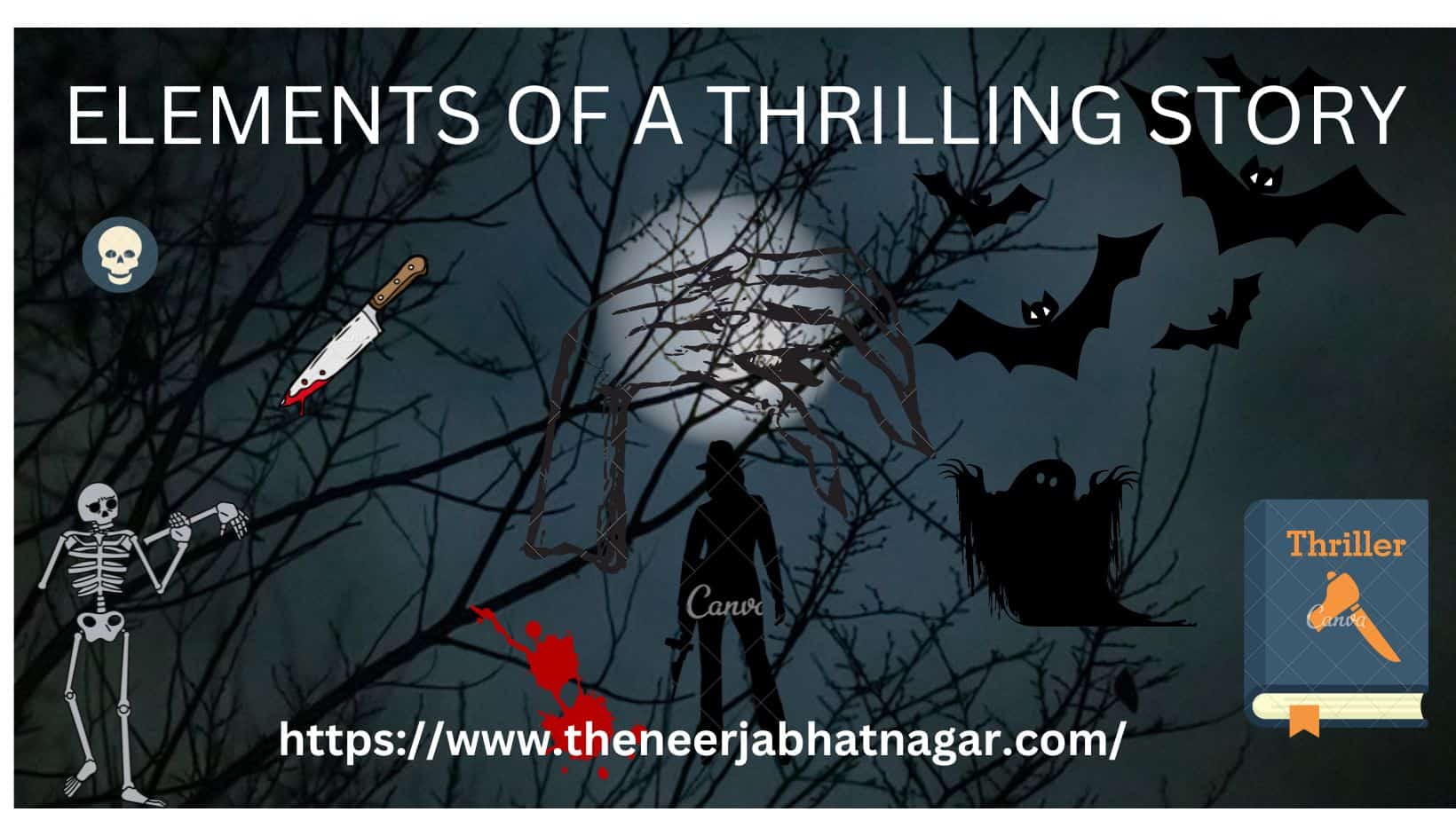.

There’s nothing quite like getting lost in a good story. Whether it’s a book, a movie, or a TV show, a thrilling story can captivate your imagination and keep you on the edge of your seat. But what makes a story truly thrilling? In this blog post, we’ll explore the key elements of a thrilling story.
A thriller heightens the emotion to keep their readers hooked. They are involved in high stakes and dramatic plot points. Thriller overlaps with other genres, like mystery and crime.
They make their readers feel anxious. When a reader has a good thriller in hand, he feels unsettled, nervous, and eager to read what happens next. I think, all fiction should elicit some amount of stress in the reader in the form of conflict, but in a thriller novel, stress is the main feature.
Main Elements of a Horror Story / Novel
- Compelling Characters:
The first key element of a thrilling story is compelling characters. Whether they are heroes, villains, or something in between, characters that the reader can relate to and empathize with are crucial to any good story. A thrilling story should have well-rounded characters with unique traits, motivations, and goals that make them interesting and engaging. - Tension and Conflict: Conflict creates tension, which is essential for keeping the reader engaged. A thrilling story should have conflict in every scene, whether it’s between characters, internal conflict, or conflict with the environment. The tension should escalate as the story progresses, with each conflict more intense than the last.
- High Stakes: The stakes should be high in a thrilling story. The characters should be risking something important, like their lives, their loved ones, or their livelihoods. The consequences of failure should be severe, creating a sense of urgency and driving the action forward.
- Suspense: Suspense is created by withholding information from the reader and building up anticipation. The reader should be left wondering what will happen next, and the story should have unexpected twists and turns. A good thriller should keep the reader guessing until the very end.
- Action: Action scenes are exciting and keep the reader engaged. They should be well-written and easy to follow, with clear descriptions of what is happening. The action should be integral to the story and should not feel gratuitous or forced.
- Setting: The setting should be vivid and immersive, creating a sense of place that the reader can visualize. It can add tension to the story, such as in a dark, abandoned building or a stormy, isolated island. This should also be used to create obstacles for the characters, adding to the conflict and raising the stakes.
- Resolution: A thrilling story should have a satisfying resolution that ties up loose ends and provides closure for the reader. However, the resolution should also leave room for the reader to imagine what might happen next. The resolution should not be predictable or overly tidy but should feel earned and satisfying.
- Realistic pacing: The nonstop action in the story will make the readers worn out. The real life, which we know doesn’t actually include bombs going off every now and then and shootouts around every corner. The suspense and conspiration need to be constant, but the action doesn’t have to be. More often, the interesting and punchy dialogue, dream sequences, or the character reviewing the contrasting facts and puzzle pieces is enough to keep turning the page.
Thrillers are a genre of fiction that is designed to keep the reader on the edge of their seat. They are filled with suspense, tension, and excitement, and often feature high-stakes plots and fast-paced action. However, not all thrillers are the same.
Besides the main elements of a horror story/novel, let us talk about some of the different types of thrillers and what makes them unique.
Psychological Thrillers
Psychological thrillers focus on the mental and emotional states of the characters, rather than physical action. They often feature unreliable narrators, complex relationships, and mind games that keep the reader guessing. Examples of psychological thrillers include “Gone Girl” by Gillian Flynn and “The Girl on the Train” by Paula Hawkins.
Techno Thrillers
Techno thrillers focus on technology and its impact on society. They often feature complex plots that involve computer hacking, espionage, and other high-tech elements. Examples of techno thrillers include “Jurassic Park” by Michael Crichton and “The Da Vinci Code” by Dan Brown.
Action Thrillers
Action thrillers are focused on high-octane action sequences and fast-paced plots. They often involve car chases, gunfights, and other physical feats of strength and agility. Examples of action thrillers include the “Die Hard” franchise and “The Bourne Identity” by Robert Ludlum.
Political Thrillers
Political thrillers focus on political intrigue and corruption, often featuring conspiracies and cover-ups. They may involve political figures, espionage, and government agencies. Examples of political thrillers include “All the President’s Men” by Carl Bernstein and Bob Woodward, and “The Manchurian Candidate” by Richard Condon.
Legal Thrillers
Legal thrillers are focused on legal cases and courtroom drama. They often involve lawyers, judges, and the legal system, and may feature suspenseful plot twists and surprise endings. Examples of legal thrillers include “To Kill a Mockingbird” by Harper Lee and “The Firm” by John Grisham.
Crime Thrillers
Crime thrillers focus on criminal activity, often featuring detectives, police officers, or private investigators trying to solve a crime. They may involve serial killers, heists, or other forms of criminal activity. Examples of crime thrillers include “The Silence of the Lambs” by Thomas Harris and “The Godfather” by Mario Puzo.
Thrillers come in many different shapes and sizes. From psychological thrillers to action thrillers, there is something for every reader in this exciting genre. Each type of thriller offers its own unique set of thrills and challenges, making them a favourite of readers around the world.
In conclusion, a thrilling story is one that keeps the reader engaged and on the edge of their seat. By incorporating compelling characters, tension and conflict, high stakes, suspense, action, setting, and resolution, a writer can create a story that is truly thrilling.
This post is a part of Blogchatter Bloghop.
Neerja Bhatnagar
Connect with me on Instagram & Facebook.
Gupshup – Aayiye kuch baatein Karte Hain.

I liked reading about the different types of thrillers, especially legal thrillers.
A good guide for aspiring story writers.